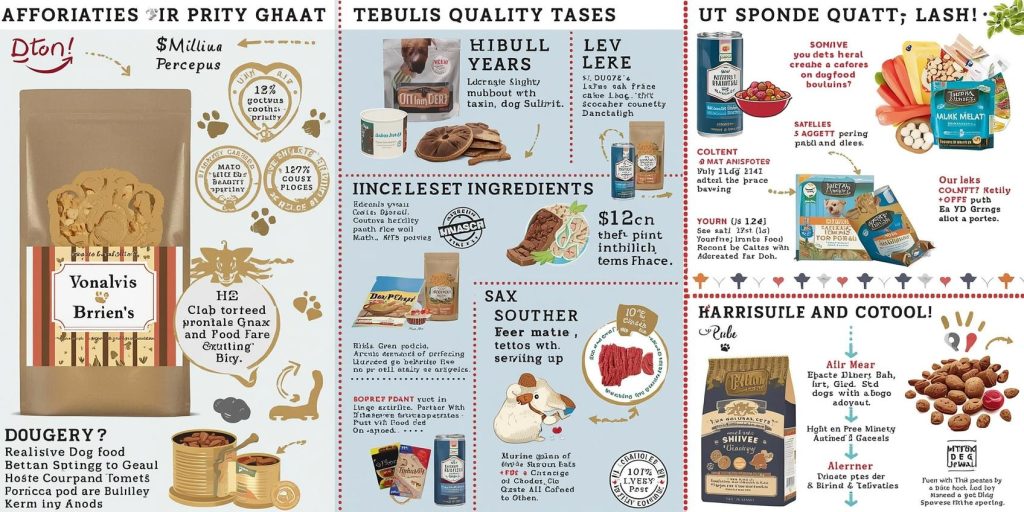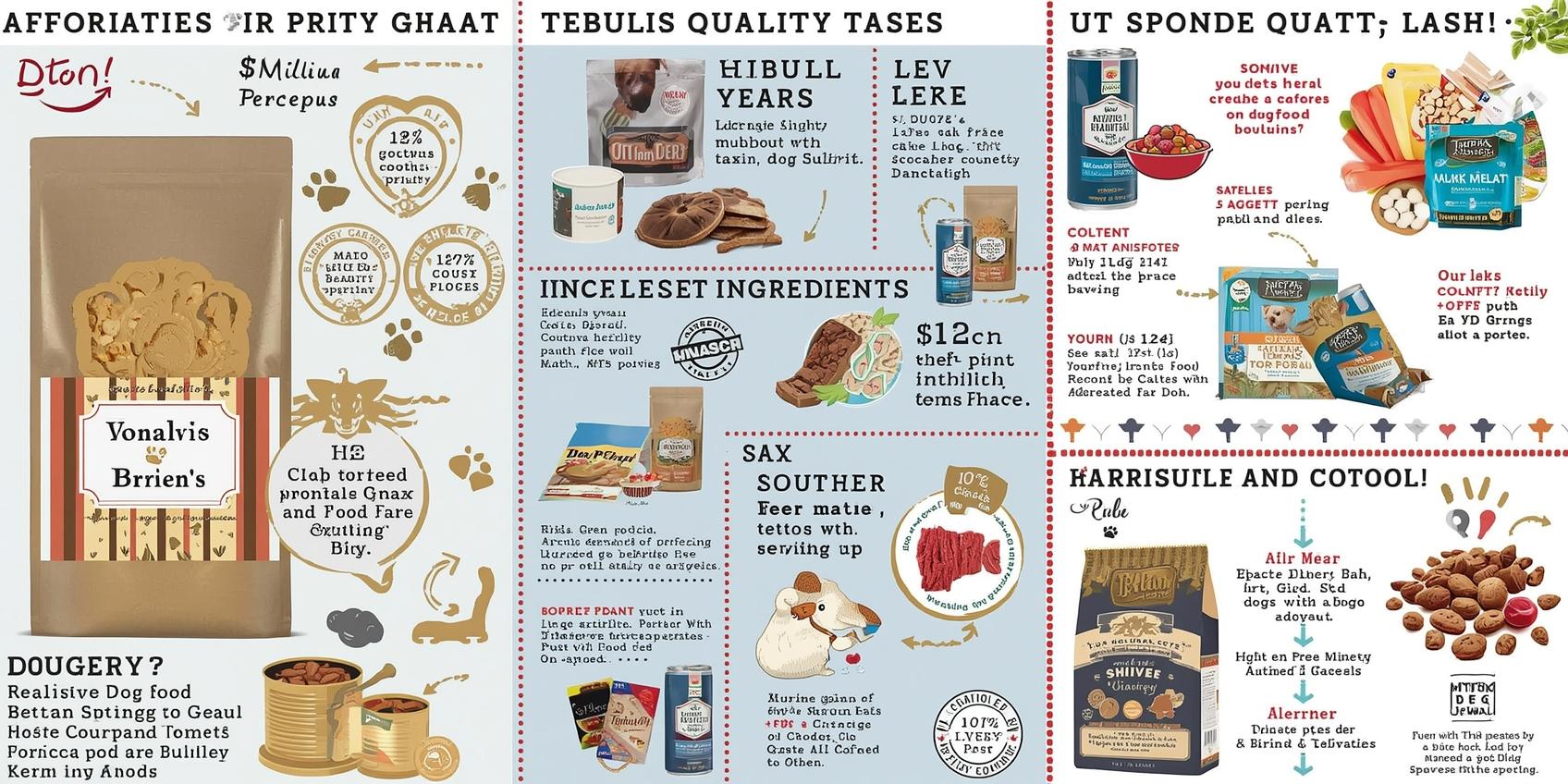Affordable Dog Foods That Don’t Compromise on Quality

Affordable Dog Foods That Don’t Compromise on Quality
Finding affordable dog food that still offers high quality is entirely possible! Look for brands that list a named meat source (like “chicken” or “beef”) as the first ingredient, avoid excessive fillers, and carry an AAFCO statement. Many budget-friendly options provide complete and balanced nutrition, ensuring your dog thrives without breaking your bank.
Many dog owners face a common dilemma: how to provide their beloved furry friends with nutritious meals without spending a fortune. It’s a frustrating challenge, especially with so many dog food options on the market, each promising the best for your pet. You might worry that choosing a more affordable brand means sacrificing your dog’s health or well-being. Good news! You’re in the right place to discover that quality and affordability can go hand-in-hand. This article will walk you through how to identify excellent, budget-friendly dog foods, explain what to look for on labels, and highlight top brands that deliver on both fronts. Let’s explore how to keep your dog healthy and happy without emptying your wallet.
Understanding Quality Dog Food on a Budget
When we talk about “quality” dog food, it doesn’t always mean the most expensive bag on the shelf. Instead, quality refers to the nutritional value and the digestibility of the ingredients for your dog. A high-quality food provides all the essential nutrients your dog needs for energy, growth, and overall health, in a form their body can easily use.
What Does “Quality” Truly Mean?
- Nutritional Completeness: The food must provide a balanced diet, meaning it contains the right proportions of proteins, fats, carbohydrates, vitamins, and minerals. Look for a statement from the Association of American Feed Control Officials (AAFCO) on the label, which indicates the food meets established nutritional standards for a specific life stage (e.g., “for all life stages,” “for adult maintenance,” or “for growth and reproduction”).
- Ingredient Quality: This doesn’t necessarily mean exotic ingredients. It means recognizable, wholesome ingredients that serve a purpose. A named meat source (like “chicken meal” or “beef”) as one of the first few ingredients is a good sign.
- Digestibility: Even the best ingredients won’t help if your dog can’t digest them properly. Quality foods are formulated for high digestibility, leading to better nutrient absorption and smaller, firmer stools.
Common Misconceptions About Cheap Dog Food
Many people assume that cheaper dog foods are automatically bad. This isn’t always true. While some very low-cost foods might use less optimal ingredients, many affordable brands have significantly improved their formulations over the years. They can offer lower prices due to:
- Volume Production: Large companies can buy ingredients in bulk and produce food on a massive scale, reducing per-unit costs.
- Less Marketing Hype: Some affordable brands focus less on elaborate packaging or extensive advertising campaigns, passing those savings onto consumers.
- Ingredient Sourcing: They might source ingredients more efficiently or use common, readily available ingredients that are still nutritious but less expensive than niche or “boutique” ingredients.
The key is to learn how to differentiate between genuinely poor-quality food and genuinely good, yet affordable, food.
Key Ingredients to Look For (and Avoid)
Reading a dog food label can feel like deciphering a secret code. Knowing which ingredients are beneficial and which to approach with caution is crucial for making an informed decision, especially when balancing quality with cost.
Ingredients to Look For:
- Named Meat Source: Look for “chicken,” “beef,” “lamb,” “salmon,” or “turkey” as the first or second ingredient. Meat meal (e.g., “chicken meal”) is also excellent; it’s a concentrated form of meat with much of the water removed, meaning more protein per serving.
- Whole Grains (if applicable): For dogs without grain sensitivities, whole grains like brown rice, barley, oats, or quinoa provide essential carbohydrates for energy and fiber for digestion.
- Healthy Fats: Sources like chicken fat, flaxseed, or fish oil (e.g., salmon oil) provide omega-3 and omega-6 fatty acids, vital for skin, coat, and brain health.
- Fruits and Vegetables: Ingredients like peas, carrots, sweet potatoes, apples, and cranberries offer vitamins, minerals, antioxidants, and fiber.
- Prebiotics and Probiotics: These support digestive health. Look for ingredients like chicory root, dried fermentation products, or specific probiotic strains.
Ingredients to Approach with Caution (or Avoid):
- Generic “Meat By-Products” or “Animal Fat”: While not inherently bad, these generic terms don’t specify the animal source, making it harder to assess quality or potential allergens. Named by-products (e.g., “chicken by-product meal”) are generally acceptable as long as they are from a healthy source.
- Excessive Fillers: Ingredients like corn gluten meal, wheat gluten, or soy can be used as cheap protein boosters but offer less nutritional value than whole meat. Large amounts of corn or wheat can also be fillers, though small amounts in whole form can be beneficial.
- Artificial Colors, Flavors, and Preservatives: Ingredients like BHA, BHT, ethoxyquin, Red 40, Blue 2, or Yellow 5/6 offer no nutritional benefit and can sometimes be linked to health issues or sensitivities in some dogs. Natural preservatives like mixed tocopherols (Vitamin E) are preferred.
- “Sweeteners”: Corn syrup, sucrose, or other added sugars are unnecessary and can contribute to weight gain and dental problems.
Good vs. Bad Ingredients at a Glance
Here’s a quick guide to help you scan those ingredient lists:
| Category | Good Indicators | Red Flags / To Avoid |
|---|---|---|
| Protein Source | Named meat (Chicken, Beef, Salmon), Named meat meal (Chicken Meal, Lamb Meal) | Meat By-Products, Animal Digest, Generic “Meat” |
| Carbohydrates/Fibers | Brown Rice, Oats, Barley, Sweet Potato, Peas, Lentils | Corn Gluten Meal, Wheat Gluten, Excessive Corn/Wheat as primary ingredients, Brewers Rice |
| Fats | Chicken Fat, Salmon Oil, Flaxseed, Sunflower Oil | Animal Fat (unspecified), Rendered Fat |
| Additives | Mixed Tocopherols (Vitamin E), Rosemary Extract, Natural Flavors | BHA, BHT, Ethoxyquin, Artificial Colors (e.g., Red 40), Artificial Flavors, Propylene Glycol |
| Sweeteners | Naturally occurring sugars from fruits/veg | Corn Syrup, Sucrose, Cane Molasses |
Top Affordable Dog Food Brands That Deliver
Now that you know what to look for, let’s explore some popular and highly-rated affordable dog food brands that consistently offer quality nutrition without the premium price tag. Remember, prices can vary based on region, retailer, and bag size.
1. Purina ONE
- Overview: Purina ONE is a widely available brand that focuses on scientifically formulated nutrition. They offer various formulas tailored to specific needs, such as healthy weight, sensitive systems, or large breeds.
- Key Features: Real meat as the first ingredient, natural sources of glucosamine for joint health (in some formulas), and omega-6 fatty acids for a healthy coat. They often have visible pieces of real meat mixed in.
- Why It’s a Good Choice: Purina is a highly reputable company with extensive research behind its products. Purina ONE provides complete and balanced nutrition that meets AAFCO standards, making it a reliable choice for everyday feeding.
- Typical Price Range: Mid-range, very accessible.
- Amazon Link (Example): Purina ONE SmartBlend Adult Dry Dog Food, Chicken & Rice Formula
2. Iams ProActive Health
- Overview: Iams has been a staple in pet nutrition for decades, known for its commitment to digestible ingredients and tailored formulas.
- Key Features: Formulated with high-quality animal protein, prebiotics for healthy digestion, and essential nutrients for strong bones and muscles. They offer options for puppies, adults, seniors, and various breed sizes.
- Why It’s a Good Choice: Iams consistently provides good value. Their foods are highly palatable for most dogs and deliver on the promise of complete nutrition with readily available ingredients.
- Typical Price Range: Mid-range, similar to Purina ONE.
- Amazon Link (Example): Iams ProActive Health Adult Dry Dog Food, Chicken
3. Diamond Naturals
- Overview: Diamond Naturals positions itself as a premium, holistic brand at an affordable price point. They emphasize quality ingredients, often with added probiotics and superfoods.
- Key Features: Real meat protein, fruits, vegetables, and superfoods (like kale, blueberries, and chia seeds). Many formulas are grain-inclusive, but they also offer grain-free options. Contains guaranteed levels of probiotics.
- Why It’s a Good Choice: For those seeking a more “natural” or “holistic” option without the high cost, Diamond Naturals is an excellent choice. Their focus on wholesome ingredients and added digestive support makes them stand out in the budget category.
- Typical Price Range: Mid-to-upper affordable range.
- Amazon Link (Example): Diamond Naturals Adult Dry Dog Food, Chicken & Rice Formula
4. Kirkland Signature (Costco Brand)
- Overview: Exclusively available at Costco, Kirkland Signature pet foods are often manufactured by Diamond Pet Foods, which also makes Diamond Naturals. This means you’re getting a similar quality product at a bulk discount.
- Key Features: High-quality protein sources (often chicken or lamb), whole grains, fruits, and vegetables. Many formulas include probiotics and omega fatty acids.
- Why It’s a Good Choice: If you have a Costco membership and can buy in bulk, Kirkland Signature offers exceptional value. The quality-to-price ratio is hard to beat, making it a top pick for multi-dog households or those looking to save significantly.
- Typical Price Range: Very affordable, especially in bulk.
- Amazon Link (Not direct, but similar quality): (As this is a Costco exclusive, a direct Amazon link is not feasible. Consider linking to a similar Diamond Naturals product or advising Costco purchase.)
5. Victor Classic
- Overview: Victor is a family-owned company based in Texas, known for its nutrient-dense formulas. Their classic line offers robust nutrition at a competitive price.
- Key Features: All Victor formulas feature their proprietary “VPRO Blend” of ingredients designed to support immune health, digestion, and healthy skin and coat. They use multiple meat proteins.
- Why It’s a Good Choice: Victor provides high-protein, nutrient-rich food often favored by active dogs or those needing more robust nutrition. It’s a step up in ingredient quality from some other budget brands while remaining very affordable for its nutritional profile.
- Typical Price Range: Mid-to-upper affordable range.
- Amazon Link (Example): Victor Classic Hi-Pro Plus Dry Dog Food
Brand Comparison Table
Here’s a quick comparison of some of these excellent affordable brands:
| Brand | Primary Protein Source | Key Feature | Typical Price Per Pound (Approx.) | Availability |
|---|---|---|---|---|
| Purina ONE | Chicken, Beef, Lamb | Scientifically formulated, visible meat pieces | $1.50 – $2.00 | Major retailers, online |
| Iams ProActive Health | Chicken, Lamb | Digestible, prebiotics for gut health | $1.50 – $2.00 | Major retailers, online |
| Diamond Naturals | Chicken, Lamb, Beef, Salmon | Holistic, probiotics, superfoods | $1.80 – $2.50 | Pet specialty stores, online |
| Kirkland Signature | Chicken, Lamb, Salmon | Excellent value, often made by Diamond | $1.00 – $1.50 | Costco Wholesale |
| Victor Classic | Beef, Pork, Chicken | Nutrient-dense, VPRO Blend for active dogs | $2.00 – $2.80 | Pet specialty stores, farm supply, online |
Note: Prices are estimates and can vary significantly based on location, retailer, and specific formula.
Smart Shopping Strategies for Dog Food
Beyond choosing the right brand, smart shopping habits can significantly reduce your dog food expenses without compromising on quality.
1. Buy in Bulk
Larger bags almost always offer a lower price per pound. If you have the storage space and your dog goes through food quickly, buying the largest available bag can lead to substantial savings. Just ensure the food stays fresh; airtight containers are essential.
2. Check Sales and Coupons
Keep an eye out for sales at your local pet stores, supermarkets, and online retailers. Sign up for email newsletters from your preferred brands and stores to receive notifications about discounts and exclusive coupons. Websites like Coupons.com or brand-specific sites often have printable coupons.
3. Utilize Loyalty Programs
Many pet stores (both physical and online) offer loyalty programs that reward frequent purchases. These can include points that convert to discounts, exclusive member pricing, or “buy X, get Y free” deals on dog food.
4. Compare Online vs. In-Store Prices
Online retailers like Amazon, Chewy, and Petco.com often have competitive pricing, especially for larger bags. Don’t forget to factor in shipping costs (or look for free shipping options). Sometimes, local stores will price match, so it pays to compare before you buy.
5. Consider Subscription Services
Many online retailers offer “subscribe and save” options, where you set up recurring deliveries of your dog food. These subscriptions often come with a discount (e.g., 5-15% off) and the convenience of never running out of food. You can usually adjust the delivery frequency as needed.
6. Store Brand Alternatives
As mentioned with Kirkland Signature, many large retailers (like Walmart’s Pure Balance or Tractor Supply’s 4Health) offer their own private-label dog foods. These are often manufactured by reputable pet food companies and provide excellent quality at a lower price point than national brands.
Supplementing on a Budget (If Necessary)
For most healthy dogs on a complete and balanced commercial diet, additional supplements are not necessary. However, there might be specific situations where a veterinarian recommends a supplement. If this is the case, there are still budget-friendly ways to provide them.
When to Consider Supplements:
- Joint Support: For older dogs, large breeds, or those prone to arthritis, glucosamine and chondroitin can be beneficial.
- Skin & Coat Health: If your dog has dry, flaky skin or a dull coat, omega-3 fatty acid supplements (like fish oil) can help.
- Digestive Issues: Probiotics can be useful for dogs with chronic mild digestive upset or during/after antibiotic treatment.
- Vet Recommendation: Always consult your veterinarian before adding any supplements to your dog’s diet. They can assess your dog’s specific needs and recommend appropriate, safe dosages.
Budget-Friendly Supplement Options:
- Human-Grade Fish Oil: Often cheaper than pet-specific brands, as long as it’s pure fish oil (salmon, anchovy, sardine) and dosed correctly by your vet. Look for products tested for heavy metals.
- Green-Lipped Mussel Powder: A natural source of glucosamine, chondroitin, and omega-3s, often more affordable than synthetic joint supplements.
- Plain Pumpkin Puree: (Not pie filling!) A great source of fiber for mild digestive upset (constipation or diarrhea) and very inexpensive.
- Probiotic Yogurt/Kefir: Small amounts of plain, unsweetened yogurt or kefir with live active cultures can provide beneficial bacteria. Always check for xylitol, which is toxic to dogs.
Remember, supplements are meant to *supplement* a complete diet, not replace essential nutrients. Always prioritize a high-quality base food.
Reading Dog Food Labels Like a Pro
Understanding dog food labels is your superpower in finding affordable quality. Here’s what each section means and what to focus on:
1. Guaranteed Analysis
This section lists the minimum percentage of crude protein and crude fat, and the maximum percentage of crude fiber and moisture. While useful, these are minimums and maximums, not exact values. They tell you the basic nutrient profile but not the quality or digestibility.
- Crude Protein: Aim for at least 18-25% for adult maintenance, higher for puppies or active dogs.
- Crude Fat: Typically 8-15% for adults, higher for active dogs, lower for weight management.
- Crude Fiber: Around 3-5% is common; higher for weight loss, lower for highly digestible foods.
- Moisture: Dry kibble usually has 10% or less. Wet food will have a much higher percentage.
2. Ingredient List Order
Ingredients are listed by weight before processing. This means the first few ingredients make up the largest portion of the food. Look for a named meat source (e.g., “chicken” or “lamb meal”) as the first ingredient. If a grain or vegetable is listed first, it might mean the food is less meat-centric, but this isn’t always a deal-breaker if the overall protein content is still good.
- “Splitting” Ingredients: Be aware of “ingredient splitting,” where a single ingredient is broken into multiple forms (e.g., “corn,” “corn gluten meal,” “corn bran”). If combined, corn might be the most prominent ingredient, even if it appears lower on the list.
3. Nutritional Adequacy Statement (AAFCO Statement)
This is arguably the most important part of the label. It tells you if the food provides complete and balanced nutrition for a specific life stage. Look for phrases like:
- “Formulated to meet the nutritional levels established by the AAFCO Dog Food Nutrient Profiles for [Life Stage, e.g., Adult Maintenance, Growth, All Life Stages].”
- “Animal feeding tests using AAFCO procedures substantiate that [Product Name] provides complete and balanced nutrition for [Life Stage].”
The second statement (feeding tests) is generally considered more rigorous, but both indicate a nutritionally complete food.
4. Feeding Guidelines
These provide a starting point for how much to feed your dog based on their weight. However, these are just guidelines. Your dog’s individual metabolism, activity level, and age will dictate the exact amount. Monitor your dog’s weight and body condition and adjust accordingly. Overfeeding, even good quality food, can lead to obesity.
When to Consult Your Vet
While this guide helps you choose affordable, quality food, your veterinarian remains your best resource for your dog’s specific dietary needs. Always consult them if:
- You’re Transitioning Foods: Your vet can advise on the best way to gradually switch your dog’s food to avoid digestive upset.
- Your Dog Has Specific Health Conditions: Dogs with allergies, kidney disease, diabetes, or other conditions often require specialized diets. Your vet can recommend therapeutic foods or specific ingredients to avoid.
- You Notice Dietary Issues: If your dog experiences persistent diarrhea, vomiting, excessive gas, skin problems, or unusual weight changes after a diet change, consult your vet immediately.
- You’re Considering Homemade Diets or Raw Feeding: These diets require careful formulation to be nutritionally complete and balanced, and often need veterinary or veterinary nutritionist guidance.
- You’re Adding Supplements: As mentioned, always get veterinary approval before adding any supplements to your dog’s diet to ensure they are safe and necessary.
Your vet can also help you understand your dog’s ideal body condition and caloric needs, ensuring they get the right amount of food to maintain a healthy weight. They are also a great resource for understanding the nuances of different dog breeds and their specific needs. For instance, if you’re considering which breed might be best for your family, you might find our article on 15 Best Dog Breeds for Kids and Families helpful.
Frequently Asked Questions (FAQ)
Q1: Is grain-free dog food always better for my dog?
A: Not necessarily. While some dogs do have grain sensitivities or allergies, most dogs digest grains perfectly well. Grains like brown rice, barley, and oats provide valuable nutrients and fiber. The trend of grain-free diets has been linked to potential heart issues (DCM) in some dogs, so it’s best to consult your vet before choosing a grain-free diet unless there’s a specific medical reason.
Q2: How do I switch my dog to a new food without upsetting their stomach?
A: The best way is to do it gradually over 7-10 days. Start by mixing 25% new food with 75% old food for a few days. Then, move to 50/50 for a few more days, then 75% new food to 25% old food, until you’re feeding 100% new food. This allows your dog’s digestive system to adjust.
Q3: Can I feed my dog human food scraps to save money?
A: While some human foods are safe and even healthy for dogs in moderation (like plain cooked chicken or certain vegetables), relying on human food scraps for a significant portion of their diet is generally not recommended. It’s difficult to ensure they get complete and balanced nutrition, and many common human foods are toxic to dogs (e.g., chocolate, onions, grapes, xylitol).
Q4: How can I tell if a dog food is genuinely high quality, even if it’s affordable?
A: Look for a named meat source as the first ingredient, an AAFCO statement indicating complete and balanced nutrition for your dog’s life stage, and a short, recognizable ingredient list free of artificial colors, flavors, and excessive generic fillers. Reputable brands that invest in research and quality control, even if they’re affordable, are often a good sign.
Q5: My dog seems to be doing fine on a very cheap food. Should I still switch?
A: While your dog might appear fine, a diet lacking in quality nutrients can lead to long-term health issues that aren’t immediately apparent. If you can afford a slightly better quality food (as outlined in this article), it’s often a worthwhile investment in your dog’s long-term health and vitality. Look for improvements in coat shine, energy levels, and stool quality.
Q6: Are wet dog foods more expensive than dry kibble?
A: Generally, yes. Wet dog food has a much higher moisture content, meaning you’re paying more for water and less for actual nutrients per ounce. While wet food can be great for hydration or palatability, it’s usually more expensive to feed exclusively than dry kibble. Many owners choose to mix a small amount of wet food with kibble as a “topper” to add variety and appeal.
Q7: What is the best way to store dog food to keep it fresh?
A: Store dry kibble in its original bag, placed inside an airtight container (plastic or metal) in a cool, dry place away from direct sunlight. This helps prevent spoilage, keeps pests out, and retains freshness. Avoid storing food in hot or humid areas like garages. Wet food, once opened, should be refrigerated in an airtight container and used within 3-5 days.
Conclusion
Providing your dog with high-quality nutrition doesn’t have to be a financial burden. By understanding what constitutes a good dog food, learning to read labels, and employing smart shopping strategies, you can confidently choose affordable options that support your dog’s health and happiness. Remember to prioritize named meat sources, AAFCO statements, and simple, wholesome ingredients. With a little research and savvy shopping, you can ensure your beloved companion thrives without compromising on their well-being or your budget. Your dog deserves the best, and thankfully, the “best” can often be quite affordable.


